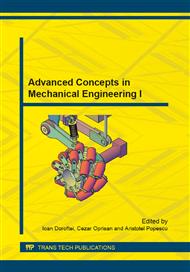p.77
p.83
p.89
p.95
p.99
p.105
p.111
p.117
p.123
Low Speed Linear Actuator for Accurate Orientation of Concentrated Solar Convertors
Abstract:
The accurate orientation of concentrated solar converters (e.g. solar parabolic dish, concentrated photovoltaic) requires small stepwise angular displacements at short intervals of time aiming to track accurately the sun. These tracking systems are usually operated, especially the elevation movement, by low speed linear actuators (LSLA) with special configuration. The main drawbacks of the known LSLA solutions refers to the high constructive complexity of the intermediate gear reducer and its relative low efficiency due to the high value of the kinematic ratio, required to harmonize high speed motors and low speed outputs. The paper presents a geometrical synthesis algorithm and kinematic simulations of a new LSLA variant, proposed by the authors, consisting of a classical electrical motor (AC or DC), a linkage reducer transmitting intermittently the motion to a final irreversible screw-nut transmission through backstopping clutches. Compared to the known solutions, the proposed actuator has the advantage of decreasing the structural, constructive and technological complexity of the intermediate gear reducer (between the motor and the irreversible screw-nut transmission) by replacing it with a linkage type speed reducer and backstopping clutches, achieving a fixed or adjustable high kinematic ratio.
Info:
Periodical:
Pages:
99-104
Citation:
Online since:
October 2014
Authors:
Price:
Сopyright:
© 2014 Trans Tech Publications Ltd. All Rights Reserved
Share:
Citation:


